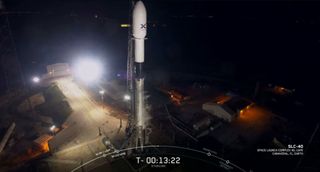
SpaceX will have to wait at least one more day to start setting up its internet-satellite megaconstellation.
A Falcon 9 rocket was scheduled to launch the first 60 of SpaceX's Starlink satellites tonight (May 15) from Cape Canaveral Air Force Station in Florida, but Mother Nature didn't cooperate: Strong high-altitude winds forced the company to push the attempt by 24 hours.
SpaceX made that call just seconds before beginning its launch livestream at 10:45 p.m. EDT (0245 GMT).
Related: SpaceX's Falcon 9: Rocket for the Dragon
Standing down today due to excess upper level winds. Teams are working toward tomorrow's backup launch window, which opens at 10:30 p.m. EDTMay 16, 2019
The next liftoff opportunity will come tomorrow (May 16) at 10:30 p.m. EDT (0230 GMT on May 17), SpaceX representatives said. You can watch it live here at Space.com when the time comes, courtesy of SpaceX, or directly via the spaceflight company.
The launch will also feature a landing attempt by the Falcon 9's first stage on one of SpaceX's drone ships in the Atlantic Ocean. This particular first stage already has two flights, and two successful touchdowns, under its belt.
Starlink is designed to provide affordable internet access to people around the world. But these first 60 satellites won't be nearly enough to get that job done: Six more such launches will be needed to provide "minor" coverage, and 12 are required for "moderate" coverage, SpaceX representatives have said.
Get the Space.com Newsletter
Breaking space news, the latest updates on rocket launches, skywatching events and more!
And the constellation could get much bigger still, eventually numbering in the thousands, company founder and CEO Elon Musk has said.
This will be the second Starlink launch SpaceX has performed. The company launched two prototype spacecraft nicknamed Tintin A and Tintin B in February 2018.
- See the Evolution of SpaceX's Rockets in Pictures
- In Photos: SpaceX's 1st Falcon Heavy Rocket Test Launch Success!
- Elon Musk: Private Space Entrepreneur
Mike Wall's book about the search for alien life, "Out There" (Grand Central Publishing, 2018; illustrated by Karl Tate), is out now. Follow him on Twitter @michaeldwall. Follow us on Twitter @Spacedotcom or Facebook.
Join our Space Forums to keep talking space on the latest missions, night sky and more! And if you have a news tip, correction or comment, let us know at: community@space.com.

Michael Wall is a Senior Space Writer with Space.com and joined the team in 2010. He primarily covers exoplanets, spaceflight and military space, but has been known to dabble in the space art beat. His book about the search for alien life, "Out There," was published on Nov. 13, 2018. Before becoming a science writer, Michael worked as a herpetologist and wildlife biologist. He has a Ph.D. in evolutionary biology from the University of Sydney, Australia, a bachelor's degree from the University of Arizona, and a graduate certificate in science writing from the University of California, Santa Cruz. To find out what his latest project is, you can follow Michael on Twitter.
Most Popular


